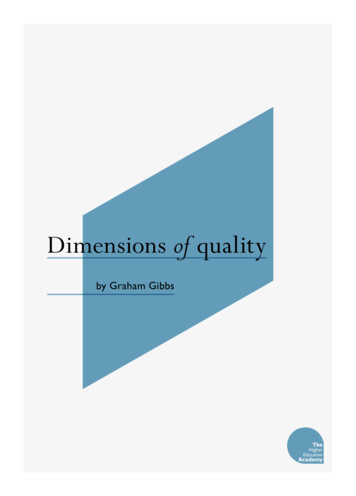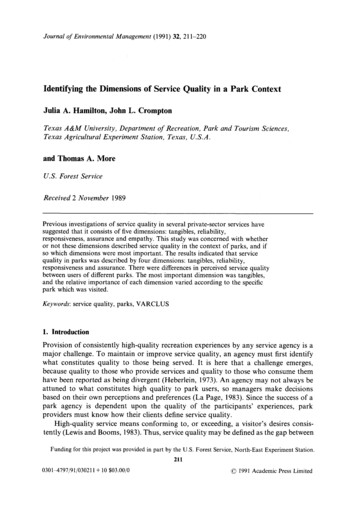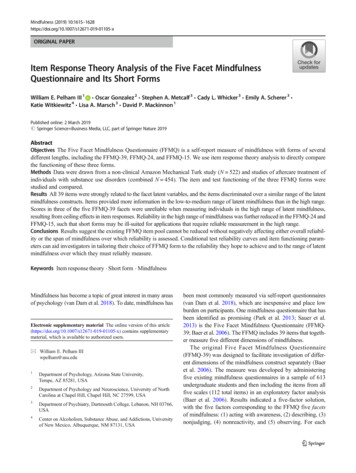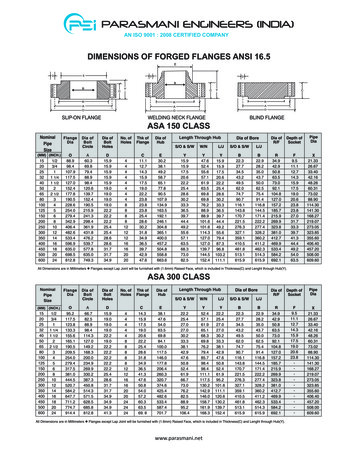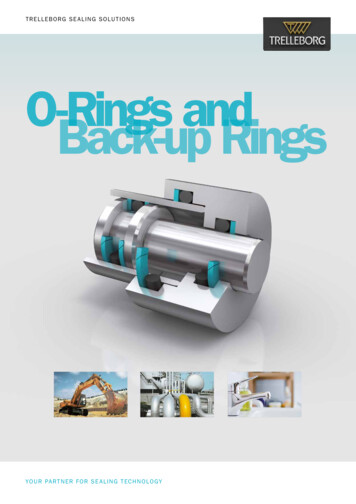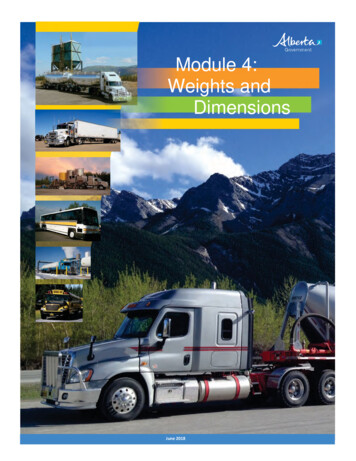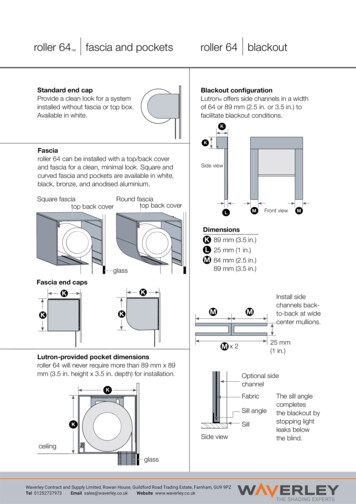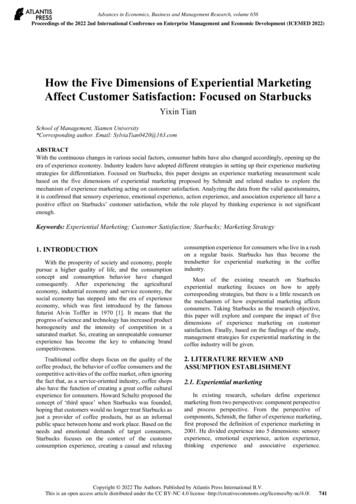
Transcription
Advances in Economics, Business and Management Research, volume 656Proceedings of the 2022 2nd International Conference on Enterprise Management and Economic Development (ICEMED 2022)How the Five Dimensions of Experiential MarketingAffect Customer Satisfaction: Focused on StarbucksYixin TianSchool of Management, Xiamen University*Corresponding author. Email: SylviaTian0420@163.comABSTRACTWith the continuous changes in various social factors, consumer habits have also changed accordingly, opening up theera of experience economy. Industry leaders have adopted different strategies in setting up their experience marketingstrategies for differentiation. Focused on Starbucks, this paper designs an experience marketing measurement scalebased on the five dimensions of experiential marketing proposed by Schmidt and related studies to explore themechanism of experience marketing acting on customer satisfaction. Analyzing the data from the valid questionnaires,it is confirmed that sensory experience, emotional experience, action experience, and association experience all have apositive effect on Starbucks’ customer satisfaction, while the role played by thinking experience is not significantenough.Keywords: Experiential Marketing; Customer Satisfaction; Starbucks; Marketing Strategy1. INTRODUCTIONWith the prosperity of society and economy, peoplepursue a higher quality of life, and the consumptionconcept and consumption behavior have changedconsequently. After experiencing the agriculturaleconomy, industrial economy and service economy, thesocial economy has stepped into the era of experienceeconomy, which was first introduced by the famousfuturist Alvin Toffler in 1970 [1]. It means that theprogress of science and technology has increased producthomogeneity and the intensity of competition in asaturated market. So, creating an unrepeatable consumerexperience has become the key to enhancing brandcompetitiveness.Traditional coffee shops focus on the quality of thecoffee product, the behavior of coffee consumers and thecompetitive activities of the coffee market, often ignoringthe fact that, as a service-oriented industry, coffee shopsalso have the function of creating a great coffee culturalexperience for consumers. Howard Schultz proposed theconcept of ‘third space’ when Starbucks was founded,hoping that customers would no longer treat Starbucks asjust a provider of coffee products, but as an informalpublic space between home and work place. Based on theneeds and emotional demands of target consumers,Starbucks focuses on the context of the customerconsumption experience, creating a casual and relaxingconsumption experience for consumers who live in a rushon a regular basis. Starbucks has thus become thetrendsetter for experiential marketing in the coffeeindustry.Most of the existing research on Starbucksexperiential marketing focuses on how to applycorresponding strategies, but there is a little research onthe mechanism of how experiential marketing affectsconsumers. Taking Starbucks as the research objective,this paper will explore and compare the impact of fivedimensions of experience marketing on customersatisfaction. Finally, based on the findings of the study,management strategies for experiential marketing in thecoffee industry will be given.2. LITERATURE REVIEW ANDASSUMPTION ESTABLISHMENT2.1. Experiential marketingIn existing research, scholars define experiencemarketing from two perspectives: component perspectiveand process perspective. From the perspective ofcomponents, Schmidt, the father of experience marketing,first proposed the definition of experience marketing in2001. He divided experience into 5 dimensions: sensoryexperience, emotional experience, action experience,thinking experience and associative experience.Copyright 2022 The Authors. Published by Atlantis Press International B.V.This is an open access article distributed under the CC BY-NC 4.0 license 1
Advances in Economics, Business and Management Research, volume 656Businesses can create experiential marketing strategiesbased on each of the five dimensions [2]. In terms of theprocess of experiential marketing, Guoqing Guo, aChinese scholar, believes that experience marketing is amarketing model in which companies design marketingconcepts based on the five dimensions proposed bySchmidt. Companies use their products or services astools for marketing activities to stimulate and satisfycustomers' experience needs so as to achieveorganizational goals eventually [3].2.2. Customer satisfactionH2: Emotional experience created by Starbuckspositively affects the customer satisfaction.H3: Action experience created by Starbuckspositively affects the customer satisfaction.H4: Thinking experience created by Starbuckspositively affects the customer satisfaction.H5: Associative experience created by Starbuckspositively affects the customer satisfaction.3. RESEARCH DESIGNAcademics mainly define customer satisfaction fromtwo perspectives. Scholars who gave definitions from theprocess perspective, such as Hunt, believe that customersatisfaction is based on the feelings of customers after thewhole process of purchasing a product or service. Whenthis feeling is positive, customer satisfaction will begenerated. Others believe that customer satisfaction is astatic state of consumers' inner satisfaction with a productor service. Oliver (1981) proposed a calculation methodof customer satisfaction that equals the actual experienceof consumers minus their pre-purchase expectations [4].3.1. Questionnaire design and data collectionIn empirical studies, different scholars chose differentindicators to measure customer satisfaction. Lau and Lee(1999), in their study of customer satisfaction, classifiedthe indicators of customer satisfaction according to theperformance of the product from consumers’ perspectiveas: “I am not happy with the product; it is not as good asI expected; and I like the product very much.” In 2000,Croninetal added the indicators “I made a wise choice”and “This product and service is exactly what I need.” [5].The survey was conducted on consumers withStarbucks consumption experience, and the results werecollected mainly through the street intercept method andonline questionnaire method. 50 paper questionnaireswere distributed in Starbucks offline stores, and therewere 47 valid results. 170 questionnaires were distributedonline, and 165 valid questionnaires were received. Theoverall questionnaire return rate was 96.4%. The validquestionnaire respondents were 91 (42.9%) males and121 (57.1%) females. The largest number of respondentswere between the ages of 18-21 and 26-30, accountingfor 30.2% and 21.2%, respectively. The monthlyconsumption level of the subjects was concentrated in therange of RMB 3,000-5,000, accounting for 67.5%.2.3. Relation between experiential marketingand customer satisfactionSome scholars have studied the relationship betweenexperiential marketing and customer satisfaction in thecatering industry. Chunlian Luo (2009) classified cafecustomer experience into sensory experience, associativeexperience, community relationship, service experience,and immersion experience [6]. After empirical analysis,all factors are proved to have a positive effect oncustomer satisfaction, except for immersion experience.Yajing Bian (2012) divided brand experience intosensory experience, emotional experience, andassociative experience, and the study showed that allthree dimensions have a direct positive effect oncustomer perceived value, which in turn affects customersatisfaction evaluation [7]. Based on the results of relatedstudies, the following hypotheses for the Starbucks areproposed.H1: Sensory experience created by Starbuckspositively affects the customer satisfaction.To validate the five hypotheses proposed in theprevious module, the questionnaire is designed with 21questions using the five-point Likert scale method.Respondents should score each indicator on a scale of 1to 5 according to the actual situation. At the same time,to ensure the reliability of the data source and to facilitatedata cleaning at a later stage, the questionnaire alsoinvestigated the consumers' gender, age, occupation andmonthly income.3.2. Variables and metrics3.2.1. Independent variables1). Sensory experienceStarbucks connects with consumers through thesenses of sight, sound, taste, smell and touch to create aunique, enjoyable, and memorable sensory experience forconsumers. The visual senses include the layout ofStarbucks stores, the appearance of food and thepackaging design; the auditory senses include thebackground music in the store; the taste senses includethe taste of the drinks and pastries provided by Starbucks;the smell senses are mainly created by the smell of thecoffee beans; the tactile senses include the touch of tables,chairs and tableware; and in some Starbucks Bakerystores, customers can also touch the coffee beans.742
Advances in Economics, Business and Management Research, volume 656Table 1. Sensory Experience Measurement ScaleExperiential Marketing DimensionMeasurementVisual experienceAuditory experienceSensory experienceTaste experienceSmell experienceTactile experience2). Emotional experienceintegrate emotional elements into the consumptionscenario [8].Since its inception, Starbucks has been committed tocreating a "third space" outside of the workplace andCustomers can invite families, lovers and colleagueshome for customers. Based on deep insight of customers'to Starbucks for a relaxing and enjoyable get-together.emotional needs, they provide the appropriate stimulus toTable 2. Emotional Experience Measurement ScaleExperiential Marketing DimensionMeasurementFeel relaxed and joyfulEmotional experienceEase the stressEnhance the relationship with peersFeel cared by attendants3). Action experienceAction experiences emphasize that the brand engagesconsumers to spontaneously take part in activities thatmay change or enrich their lives. As a place with strongsocial attributes, Starbucks provides consumers withopportunities to freely and regularly interact with friends.At the same time, some stores (such as the StarbucksRoastery in Shanghai) hold regular events wherecustomers can experience the entire process of coffeegrinding and making, deepening their understanding andknowledge of coffee.Table 3. Action Experience Measurement ScaleExperiential Marketing DimensionMeasurementChange lifestylesAction experienceFeel a high sense of interaction with othersParticipate in related branding activities4). Thinking experienceIn the thinking experience dimension, Starbucksinspires customers to think about Starbucks products andservices by providing them with professional coffeeknowledge, such as how the origins and roasting methodsaffect the taste of coffee. Through reflection andspontaneous learning, customers can deepen theirunderstanding of the coffee culture and develop anemotional bond with the brand.Table 4. Thinking Experience Measurement ScaleExperiential Marketing DimensionMeasurementCuriosity is arousedThinking experienceGain new knowledgeThink about brand connotation5). Associative experienceThe associative experience is the highest level ofconsumer experience, providing customers withculturally charged activities that create a sense ofconnection and belonging to a specific social group.Through its deep brand history, distinctive brand image,and expensive pricing, Starbucks creates an associative743
Advances in Economics, Business and Management Research, volume 656experience through its customers. Consumers buyStarbucks not just for a drink, but as a symbol of taste,identity, and lifestyle.Table 5. Associative Experience Measurement ScaleExperiential Marketing DimensionMeasurementStatus can be reflectedAssociative experienceLifestyle can be representedHave a sense of belongingthe specific research fields and objectives. Synthesizingrelevant studies by J. Joseph Cronin (2000) [9], Su Lujunand Huang Fucai (2011) [10], the following indicatorshave been selected.3.2.2. Dependent variable: CustomerSatisfactionIn the empirical studies, scholars selected differentindicators for measuring customer satisfaction based onTable 6. Customer Satisfaction Measurement ScaleVariableMeasurementThis purchase is a wise decisionCustomer satisfactionFeel satisfied with overall consuming experienceHave a strong desire to re-consumegreater than 0.5. The cumulative explained variance ofthe scales ranged from 56.30% to 76.21% ( 50%). Inconclusion, the validity of the scales is good.4. DATA ANALYSIS4.1. Reliability and validity analysisFirst, the reliability of the questionnaire was testedusing the Cronbach alpha coefficient method. Thestandardized alpha coefficients for the six variables rangefrom 0.819 to 0.946, and all variables were greater than0.8, indicating that the internal reliability of themeasurement scales designed in this research is excellent.4.2. Correlation analysisThe study used Pearson's correlation coefficient totest the correlation between the variables. Based on theresults shown in table 7, it can be concluded that therelationship between customer satisfaction and the fivedimensions of experiential marketing is significantly andpositively correlated.In terms of validity, the KMO coefficients of thequestionnaires ranged from 0.687 to 0.838 and were allTable 7. Pearson Correlation 0.189***p 0.05 **p 0.014.3. Regression AnalysisThe study used multiple linear regression analysis toverify the relationship between the five dimensions ofStarbucks experiential marketing and customersatisfaction, and established a linear regression modelbetween Starbucks customer experience and customersatisfaction accordingly. The results are shown in thetable below.744
Advances in Economics, Business and Management Research, volume 656Table 8. Regression Analysis CoefficientUnstandardized .6820.008**1.362Action experience0.1420.0602.3650.019*1.277Thinking experience0.0260.0620.4200.6751.211Assoicative experience0.1090.0492.2260.027*1.060BSESensory experience0.203Emotional experienceR²F0.261F 8.941**Dependent variable:Customer satisfaction* p 0.05 ** p 0.01The study concluded that the degree of influence ofdifferent experience dimensions on customer satisfactioncan be reflected by the magnitude of the regressioncoefficients. In Table 8, the standardized regressioncoefficients of the four independent variables of sensoryexperience, emotional experience, action experience, andassociation experience are 0.203, 0.150, 0.142, and 0.109in order, among which the significance degree of sensoryexperience and emotional experience is greater than thatof action experience and association experience. Inaddition, although thinking experience was positivelycorrelated with customer satisfaction, the p-value is toohigh for the results to be significant and therefore couldnot account for the linear relationship between thinkingexperience and customer satisfaction.4.4. Summary of Data AnalysisThis study uses Starbucks as an example to explorethe relationship between experience marketing andcustomer satisfaction by conducting correlation analysisand regression analysis on the questionnaire results.The results of the correlation analysis show that allfive dimensions of experiential marketing have a positiverelationship with customer satisfaction. Based on this, thelinear regression model of customer satisfactionregarding the five dimensions of experiential marketingwas established through multiple linear regression. Asreflected by the regression coefficients, Starbucks'sensory marketing has the greatest impact on customersatisfaction, followed by emotional and actionexperiences, and marketing of associative experienceshas the least effect. Although there is a positivecorrelation between thinking experience and customersatisfaction, the results of its regression analysis are notsignificant and cannot indicate the influence of thinkingexperience on customer satisfaction.To sum up, among the five hypotheses initiallyproposed in this paper, H1, H2, H3 and H4 are proved tobe valid. H5 does not pass the significance test in theregression analysis, so this hypothesis is not valid.5. MANAGEMENT SUGGESTIONS5.1. Establishing a comprehensive sensoryexperience marketing strategySensory experience has the greatest impact oncustomer satisfaction, because the most direct way forconsumers to obtain information is through theirperception of the five senses [11]. Starbucks shouldcontinuously invest in product development and createunique, fresh and memorable product experiences forconsumers through co-branding or effective use of thebrand's existing intellectual properties.5.2. Emphasizing emotional and actionexperience marketing to enhance the bond withconsumersThe consumption motivation of Starbucks customersis not only to have a cup of coffee or find a place to rest,but also to seek a place for emotional communication orto reflect their lifestyle. So, Starbucks should activelytake measures to create enjoyable an emotional andaction experience for consumers.In terms of emotional experience marketing,Starbucks should focus on creating an emotionalatmosphere, gaining insight into consumers' emotionalchanges, and training employees to provide services withStarbucks characteristics. Regarding action experiencemarketing, Starbucks can set up bakery stores in multiplecities, hold regular coffee-related events, and encourageloyal customers to deeply participate in brand activitiesto create a unique coffee lifestyle.5.3. Moderately creating associative andthinking experienceThe experimental results proved that associativeexperience has a small impact on Starbucks customersatisfaction, and the role of thinking experience oncustomer satisfaction could not be proved. Therefore,Starbucks can hold associative and thinking experience745
Advances in Economics, Business and Management Research, volume 656marketing events with low capital investment. Forexample, building online communities to increaseconsumers' sense of belonging, and setting up in-storesalons to promote corporate culture and coffee culture.6. CONCLUSIONThis research takes Starbucks as the research objectto investigate the influence of experience marketing oncustomer satisfaction. Through reading related literature,five hypotheses were established based on the fivedimensions of experience marketing proposed bySchmidt. Drawing on the measurement index scale ofrelated studies, a questionnaire was designed toinvestigate the relationship between the five dimensionsof Starbucks experiential marketing and its customersatisfaction. The consumer experience of 211 stionnaires and online questionnaires. After collectingthe data, SPSS software was used to analyze the data forreliability, correlation and regression analysis. On thepremise of ensuring the validity of the data, the studyconcluded that among the five dimensions of experientialmarketing, all factors positively contribute to customersatisfaction except for the role of associative experienceon customer satisfaction, which could not be confirmed.And sensory experience has the greatest influence,emotional experience and action experience are second,and associative experience has the least influence. Finally,based on the research findings, three suggestions aregiven for Starbucks to develop experiential marketingstrategies.However, this study still has some shortcomings dueto the limitations of data collection, for example, theoffline research survey was conducted in only oneStarbucks store in Xiamen, so the limited data maydeviate from the overall data. Future scholars can expandthe scope of the survey on this basis to collect a largerrange of consumers' consumption experiences in order todevelop a more universal Starbucks experiencemarketing strategy.[4] Oliver, R. L. Measurement and Evaluation ofSatisfaction Processes in Retail Settings, Journal ofRetailing, vol. 57(3), 1981, pp. 25-48.[5] Li Ke. Research on cafe experience marketingstrategy based on customer satisfaction, HenanInstitute of Science and Technology, 2016.[6] Luo Chunlian. Research on the relationship betweenconsumption experience and brand loyalty - takingcoffee shop consumption experience as an example,Xiamen: Xiamen University. 2009, pp. 44-46.[7] Bian Yajing, Mao Binghuan, Zhang Zhenxing.Analysis of the influence mechanism of brandexperience on brand loyalty--an empirical studybased on restaurant brands, Mathematical Statisticsand Management, vol. 31(4), 2012, pp. 670-679.[8] Lin Ling. Exploration of brand experiencemarketing strategy and revelation - taking Starbuckscoffee in the United States as an example, NorthernLight, (05), 2019, pp. 102-103.[9] Cronin Joseph, Taylor Steven. A., SERVPERFService Quality Measure, Crossref, 1992.[10] Su Lujun, Huang Fucai, Research on the mechanismof service quality on customer loyalty - themediating role of customer consumption Themediating role of emotion, Journal of DalianUniversity of Technology (Social Science Edition),2011, pp. 7-13.[11] Liao Hongyi,Fang Meiqi. Research on the influenceof experiential marketing on consumers' willingnessto purchase-taking Runner Camp sports brand as anexample, Modern Marketing(Business Edition),(11),2020, pp. 190-192. DOI: 10.19921/j.cnki.10092994.2020.11.089.REFERENCES[1] Wang Hao, Li Huuyan, Wang Shuen. Research onthe innovation development strategy of culturaltourism industry from the perspective of experienceeconomy, Productivity Research. (6), 2021, pp. 97101.[2] BꞏJoseph Pine Ⅱ, JamesꞏHꞏ Gilmore.TheExperience Economy, Harvard Business SchoolPress, Boston, Massachusetts, 1999[3] Guo Guoqing, New Theory of ExperienceMarketing, Beijing: China Business Press, 2008: 47.746
Some scholars have studied the relationship between experiential marketing and customer satisfaction in the catering industry. Chunlian Luo (2009) classified cafe customer experience into sensory experience, associative experience, community relationship, service experience, and immersion experience [6]. After empirical analysis,



